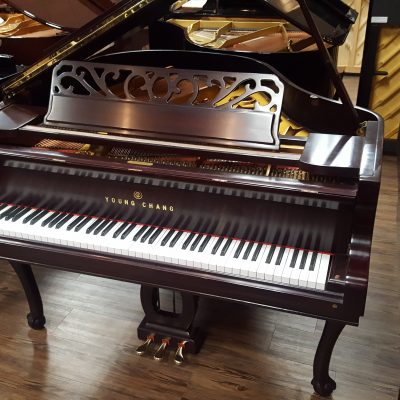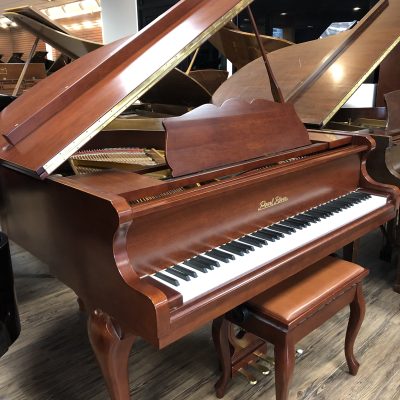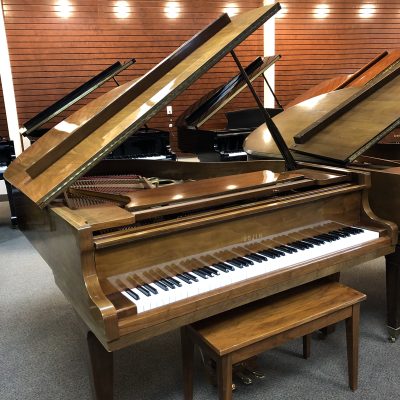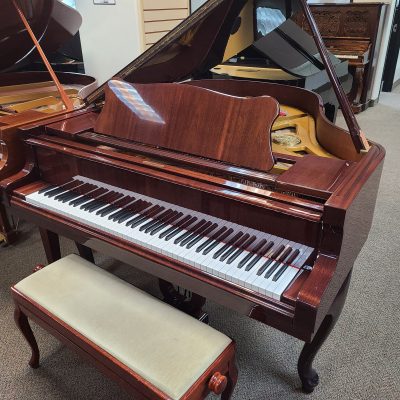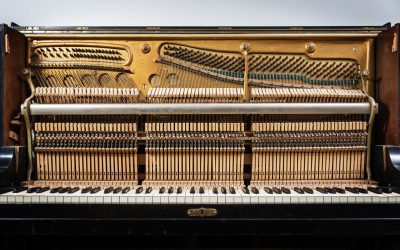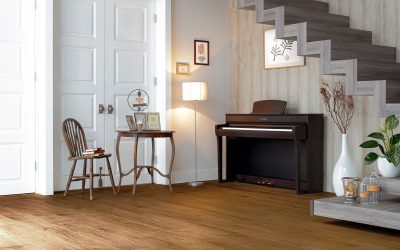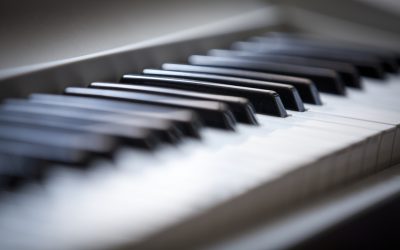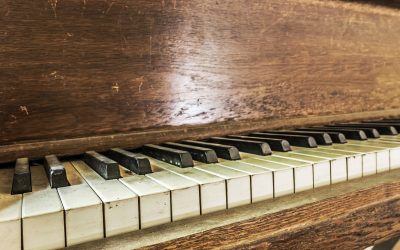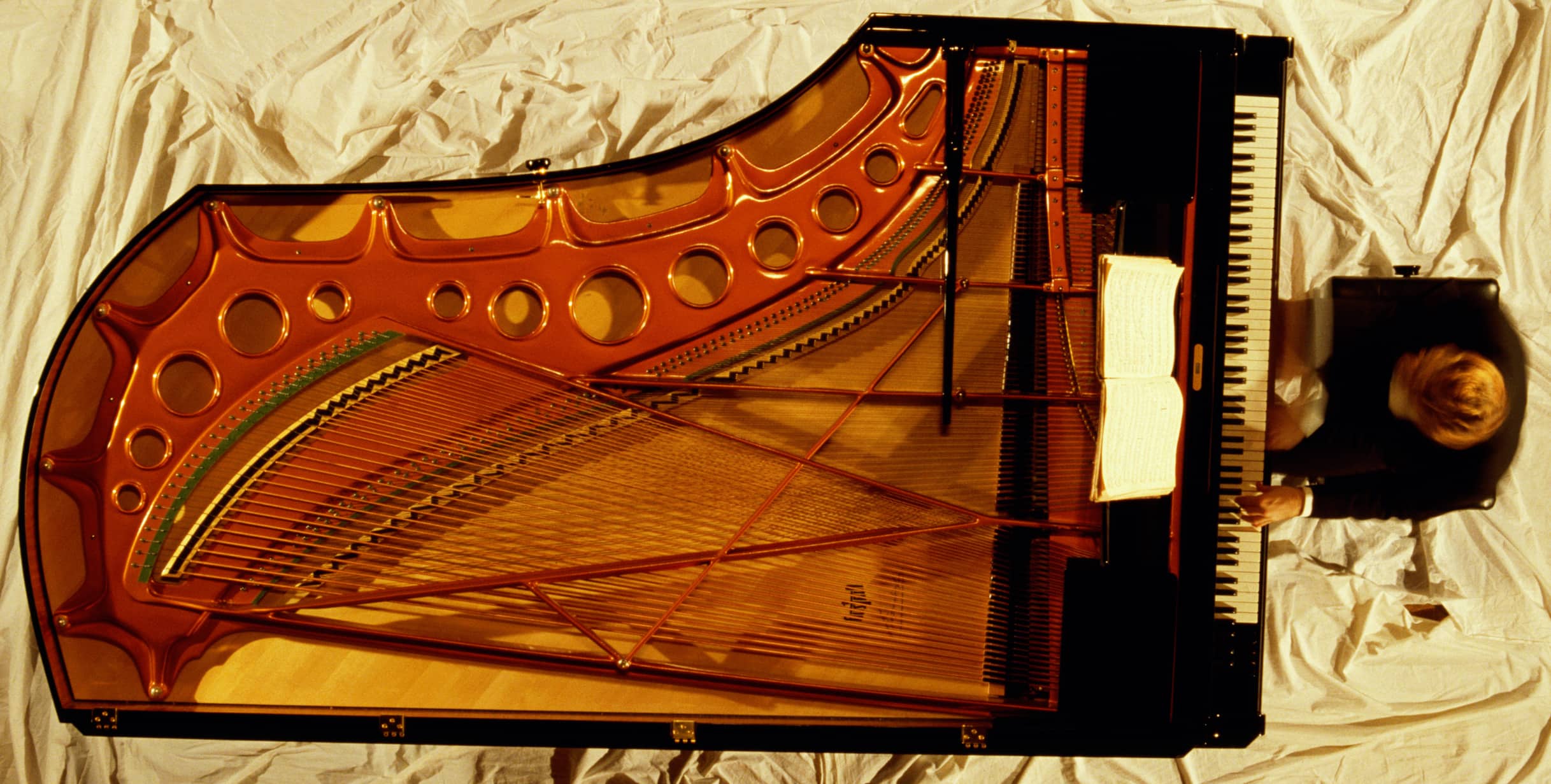
If you’re a piano player, can feel the magic of a grand piano as you play, your fingers moving across the keyboard with nuanced strokes that bring beautiful music that resounds through the instrument. Behind its elegant exterior lies a complex mechanism that translates the pianist’s touch into a symphony of sound. In this blog post, we’ll unravel how a grand piano works, from the key press to the room-filling music.
How a Grand Piano Works
A grand piano is a marvel of acoustics. The sound begins with the pressing of a key, which triggers a felt-covered hammer to strike tightly stretched strings. The force and speed of the hammer strike are influenced by the velocity with which the key is pressed. This dynamic range allows for the production of soft, mellow tones or loud, powerful crescendos. These strings vibrate, creating sound waves that resonate through the wooden soundboard, amplifying the tone. This interplay of physics and engineering allows pianists to produce a range of sounds, from gentle whispers to powerful crescendos.
1. The Key Mechanism
At the heart of the grand piano’s operation is the key mechanism. When a pianist presses a key, it sets off a series of events that ultimately produce sound. Each key is a lever, and as it is pressed, it lifts a hammer mechanism.
2. Hammer Action
The hammer action is a critical component in determining the quality of a piano’s sound. As the key is pressed, it causes the hammer to strike the strings. The precision of this mechanism ensures that each note can be played with distinct clarity and expression. Some piano brands have greater precision than others, making hammer action (or, simply, “action”) being one of the primary qualities an experience pianist will look for in a new or used piano.
Shop Used Grand Pianos
3. Strings
The strings are responsible for producing the actual sound. Grand pianos have strings of varying lengths and thicknesses, each corresponding to a specific pitch. The vibrations generated by the striking hammers travel through the strings and are then transferred to the soundboard.
4. The Soundboard
The soundboard is a large, thin wooden board positioned beneath the strings. Its role is to amplify and resonate the vibrations from the strings, enhancing the overall volume and richness of the sound. The soundboard is carefully crafted to ensure it vibrates freely and evenly across its surface.
5. Dampers and Sustain Pedal
To control the duration of each note, dampers are employed. When a key is released, the damper comes into contact with the string, stopping the vibration and ending the note. The sustain pedal, when pressed, lifts all the dampers simultaneously, allowing the strings to vibrate freely and creating a sustained sound.
6. Wooden Frame
The wooden frame of a grand piano is a crucial component. It provides the necessary support for the tension of the strings and contributes to the resonance of the instrument. The choice of wood and the construction of the frame are essential factors in determining the piano’s tonal quality.
7. Regulation and Tuning
Piano technicians perform regulation and tuning to ensure that the entire mechanism operates precisely. Regulation involves adjusting the action to achieve uniform response across all keys, while tuning ensures that each string produces the correct pitch.
What About That Large Metal Plate?
The metal part on the inside of a grand piano is called the “frame” or “plate.” This large, cast iron frame is crucial for a piano’s structure and sound. It supports the tension of the piano strings and maintains the piano’s structural integrity. The plate is also responsible for sustaining the immense string tension, which can be up to 20 tons in a concert grand piano. This component plays a key role in the piano’s ability to produce its characteristic sound and sustain long-term tuning stability.
The holes in a piano plate, also known as the cast iron frame, serve several important functions:
-
Reducing Weight: The cast iron plate is extremely heavy, and the holes help to reduce its overall weight without compromising its strength and structural integrity.
-
Acoustic Properties: The placement and size of these holes can influence the piano’s acoustic properties. They are designed to allow for optimal sound wave movement and resonance within the piano.
-
Aesthetic Design: In some pianos, the holes are also arranged in a way that contributes to the aesthetic design of the instrument.
Final Thoughts
A grand piano is not just a musical instrument; it’s a marvel of engineering and artistry. Understanding the intricate workings of its mechanism enhances our appreciation for the craftsmanship involved in creating these beautiful instruments. The next time you listen to the grandeur of a piano concerto, you can enjoy not only at the skill of the pianist but also at the mechanics that bring the music to life.
Shop Used Pianos
About the Author

Mikelle Despain
Piano Insights Author
Mikelle is a classically trained pianist and former piano teacher who has been in the piano retail industry for over 20 years. Her dream piano is a Yamaha S5X. She currently provides expert insights for Piano Gallery to share information and advice for buying, playing, and enjoying the piano. When she's not writing or playing piano, she's spending time with her four kids, tending her vegetable garden, boondock camping, hiking, or cooking overly-extravagant meals for friends.
Further Reading...
Encouraging Yourself to Play Piano More as an Adult
Playing the piano is rewarding, not only for the relaxation it provides, but also for the sense of accomplishment, confidence, and stress release if offers. However, for many adults, it can feel frivolous to take the time to play the piano. With so many other...
How to Keep Your Child Motivated to Practice the Piano
You picked the perfect piano, hired a highly-rated piano teacher, and bought your child a stack of books to learn how to play the piano—but one thing’s missing: their motivation to practice. Even if a child is super excited to learn to play the piano, there are some...
Top Health Benefits of Playing the Piano
There are many reasons people choose to play the piano—for pleasure, skill development, stress relief, and more. In this article, we explore the health and wellness benefits of playing the piano. How Playing the Piano Supports Health & Wellness Playing the piano...
Upright vs. Grand Pianos: Differences & Benefits
The choice between an upright or grand piano usually comes down to size, price, aesthetic, or all three. However, for those piano buyers who have wiggle room (literally and figuratively) in choosing a piano, the conversation about the difference between an upright and...
Yamaha U Series Upright Pianos
Yamaha is a world-renowned name in pianos because of their quality, reliability, and beauty. With a rich history of piano craftsmanship beginning in 1887, the heritage of Yamaha has made it one of the most respected names in the industry. About Yamaha’s U Series...
Yamaha Clavinova Digital Pianos: A Complete Guide
The Yamaha Clavinova is a world-renowned digital piano manufactured to emulate the touch, feel, and expression of an acoustic grand piano while offering a wide range of additional features, technology, and capabilities. In this article, we answer some of the most...
Ideas for Planning an Engaging Piano Recital
Piano recitals, especially for younger students, often have a reputation of being a little blasé. However, with the right preparation and innovation, a piano recital can be a captivating, elevated experience for its attendees. 10 Tips for a More Engaging Piano Recital...
Understanding the Difference Between a Keyboard and a Digital Piano
If you're new to the world of music or considering an upgrade from your current instrument, you might be wondering about the differences between a keyboard and a digital piano. While both instruments share similarities, they also have distinct characteristics that...
How Digital Pianos Can Enhance Music Education
For new or experienced piano students, a digital piano can be an exceptional tool for enhancing music education. This is especially true for new or young piano students. In our blog “Best Pianos for Beginners,” we further discuss this fact as we discuss our choice of...
How to Clean and Maintain Your Yamaha Clavinova
While Yamaha Clavinova digital pianos require less maintenance than digital pianos as they don’t require annual tuning, regular cleaning and maintenance can help extend the life and performance of a Clavinova. In this step-by-step guide, we walk you through the...
About Free Pianos: What to Know Before Accepting a Free Piano
If you are in the market for a pre-owned piano, you may have seen many classified ads for pianos people are giving away for free. But why are there so many free pianos and should you be wary of accepting a free piano from a friend, family member, or neighbor? Why Are...
Is Having a Piano in the Home Good for Kids?
We already know that there are several benefits to kids for learning to play the piano, but what about just having a piano in the home? For children who are still too young to play the piano or for those who have chosen to pursue other passions, there are still...
